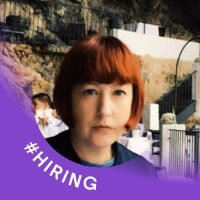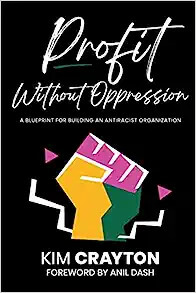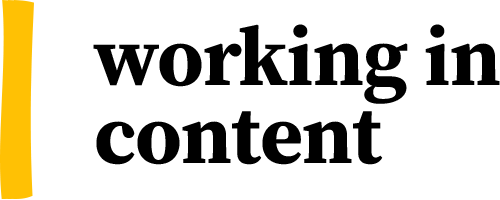One-day virtual conference: Growing In Content 2023
Redesign your career at Growing In Content 2023, whether you're aiming to climb higher in your current role or bouncing back from a career setback. Join us October 26th, 2023.
Whether you're currently working in your first content design role, or you're a job hunter looking for a way into the content design discipline, at some stage, you'll likely want to progress into a more senior position.
Well, guess what? We've spoken to content design managers, heads of content design, and content design directors, and they've offered a plethora of helpful advice and information on a number of aspects relating to working in (and towards) a managerial role in content design.
Below you'll find input from 10 seasoned professionals, including Katherine Bradshaw (BBC), Jonathon Colman (HubSpot), Kelly Chambers (Booking.com), and Jane McFadyen (DWP Digital) - all of whom are on hand to impart their insight and tips.
You'll also see a mini interview with the Founder of Content Design London, Sarah Winters. She's kindly shared her own experiences with us, as well as some sage advice for would-be content design managers!
On this page:
Moving into your first content design management role
Question #1
How can content designers demonstrate their readiness for a managerial role during interviews or performance reviews?

"A good content design manager should be able to effectively lead and motivate their team, think strategically, and communicate effectively. You can highlight your leadership skills by discussing instances where you have led successful projects, mentored others, or acted as a point of contact for stakeholders.
"Additionally, you can share examples of how you've communicated complex information, rallied team members around a project, or collaborated with experts in other fields to achieve a common goal.
"It's also important to discuss how you have handled challenges or conflict, and what you learned from those experiences. Sharing these insights can demonstrate your leadership philosophy and your ability to thrive in a managerial role."

"It's probably fair to say that most (but not all) content designers are introverts by inclination. So, one thing you need to signal is that you are interested in diverging from the 'individual contributor' path — which might feel more natural to many content designers — into helping to develop other people's skills; in other words, into management.
"To demonstrate such readiness, you could offer to mentor less experienced content designers, which is like an informal version of management. Mention your mentoring in interviews or performance reviews, ideally showing how the content design skills of the people you've mentored have, demonstrably, improved.
"Also, grab opportunities to advocate for content design skills by giving presentations and running workshops. Given that these activities involve getting on your hind feet in front of lots of people, they can be excruciating to many content designers — but being able to show how you've used such occasions to inspire people is a strong signal that you are, to use that slightly dreaded phrase, 'management material'.
"When it comes to managing projects, you need to show what lessons you've learned (about, say, working with other disciplines or producing content efficiently) from participating as a content design team member and how you're now ready to apply those lessons to projects of your own.
"Finally, allow your enthusiasm for management to show in the way you describe gaining essential management skills like helping other people to be better content designers."

"Management is all about human beings. And human beings are wonderfully complex. So, a big part of the role is understanding (and accepting) that we all show up to work a little differently every day, and working with that — rather than against it."
"If you're interviewing for a managerial role, show an awareness of how life moments, news events, mental health, or any of the other infinite human experiences can influence our working lives.
"Emotional intelligence starts with self-reflection, so draw on personal examples to talk from a place of true understanding rather than theory. The more you understand your own resilience, limitations and personal boundaries, the more equipped you'll be to support yourself and your team in a new role."
Question #2
How can content designers proactively seek out development opportunities within their current roles?

"One approach is to look for projects that have the potential to improve the overall quality of content and contribute to the success of a project or organization.
"For example, you could mentor other writers or new hires, offering guidance and support as they develop their skills. You could schedule regular check-ins, provide feedback on their work, and help them set achievable goals.
"Another option is to organize training sessions on topics that you are knowledgeable about or facilitate critiques (aka 'crits') within your area.
"It's essential to remember that these opportunities should also serve as a way to gauge your interest in a management role. While leadership and management skills are vital, it's important to ensure that you find these kinds of activities energizing and fulfilling. After all, management isn't the right fit for everyone."

"One opportunity that aspiring content design managers have is to seek to manage that peculiarly named group of people; stakeholders; particularly senior stakeholders or, to put it in plain English, 'non-UX folk with a lot of sway over a project'.
"You need to be able to show, quite precisely, how you've been able to demonstrate the value of content design to such people, and how you've been able to quell any concerns. By succeeding in this, you're indirectly also making it easier for content designers, including the people you might manage, to do their job."

"Task and line management are great ways of gaining more experience for your next role, so it's always worth asking for those opportunities if they're not forthcoming. But there are lots of other ways of growing your skills too, like:
taking on more responsibility in your community of practice
pitching for a conference talk
volunteering at a local design meet-up
"Keep an eye on content design-related Slack, Twitter, and LinkedIn groups. Opportunities often crop up in those spaces. And remember, you don't need direct reports or a specific job title to be a great leader. Leadership is multi-faceted, and everyone is welcome."
Moving into your first content design management role: useful resources
-
Career Q&A: 14 senior content designers share advice on starting and progressing your career We ask senior content designers from the industry for their tips and thoughts on several important career scenarios.
-
Content Design Panel Q+A (career progression section) All the juiciest bits from a previous AMA event with 6 content design leaders.
-
Three HubSpot content design experts share invaluable career advice and insights (career progression section) All the best bits from a HubSpot AMA event.
-
How to keep up with the changing content design field A helpful article on 'staying ahead of the curve' by Patrick Stafford
Shifting to a management mindset
So, you've clinched your first management role in content design — congratulations! But, now you've 'talked the talk' and got the position, how do you now 'walk the walk'?! Are you ready for what being more senior is really like, and what it might involve?
We chatted with our senior content design managers about their own experiences. How did they change their approach to working in content design once they'd taken that first step up? And what advice do they have for others on aspects like 'communication', based on lessons they've learned in this earlier part of their career?
Question #3
As a content design manager, how do you navigate the shift from being primarily focused on individual contributions (IC) to a more strategic, big-picture mindset?

"No matter your current job title, if you're working in a large enough organisation with content everywhere you should always be thinking 'bigger picture' and bringing an element of strategy to your work.
"For example, that could be where you're leaning on existing design patterns — or establishing them yourself because you recognise it's a common problem that needs solving in multiple places.
"It's also about being efficient and bringing value in the right places, so you're not just designing something new for the sake of it.
"I'd also say, whether you're a manager or not, pick the 'hills you want to die on' carefully and with the bigger picture in mind! Sometimes you're going to have to do things that are right for the business; not necessarily to the detriment of your users, but where there must be an element of compromise.
"Try to avoid thinking or designing 'in isolation' too. Reach out to other people — not just designers — across your organisation, and see if you can share findings, insight, research, content patterns, interaction modes whatever it might be.
"Although I'm a manager, my hands are firmly still on the tools so as an individual, I'm still making contributions, which is the way I like it! And that's nice because it means I can be ambitious and think about how something might translate into a wider strategic mission and also design micro-interactions in application forms."

"Be aware of how much hands-on involvement your organisation now expects from you — both creatively and in terms of 'process'. Could (or should) you be setting design direction on individual pieces, setting up workflows, and will you still have a few design tickets yourself?
"It's easy to say, but every organisation is different and understands the role of a content design manager slightly differently. In a smaller organisation, you might initially spend more of your time leading your team towards best practice. The larger and more mature the organisation, the easier you might find it to jump straight into strategy as you'll have a team of designers who already know good content design practice really well (that's not to say you can't change things if you disagree with the way they are).
"I think it can also feel tricky to convince the less design-savvy pockets of your organisation of your worth as a design leader.
"Designers make 'pretty screens', right?" or "product owners hand out the work — so why do we need design managers?"
"This can feel particularly hard when content design still needs so much advocacy in comparison to our compatriots in product design. I'd say this need for advocacy is actually your answer. Content design holds massive value for your organisation, so now you're a leader, you're a CHEER leader; make sure content design has its place at the table, and that it works (and works right), from creative approach to process.
"Describe yourself like that to anyone who's not getting it and it might just help".

"For me, I think it's a core (even fundamental) skill to start to think about content in the context of the whole user journey.
"If you don't already do this, then it's good to start bringing it into your work now. Challenge yourself to understand how people got to your content, why they are there, what they need to do now, and what they need to do next.
"I think that by considering individual pieces of content as just one part of a bigger, joined-up user journey, it quite naturally helps embed more strategic thinking — it's experience that's often asked for in managerial roles. The best content designers I know think this way.
"Using research to evidence decision-making also helps embed strategic thinking into your skillset. If you can collect data on how big an issue is (to prioritise work) and the negative impact, as well as measuring the outcome, then you're showing a solid process behind design to inform strategic decision-making.
"Finally, I think testing is vital. Not just to check the content works and that it fits into the wider user journey, but because it helps mitigate risk; risk that the content could be misunderstood, not understood at all, too complicated, or too vague.
"Embedding this into your process shows you are actively considering the bigger picture and thinking strategically. If the content doesn't work, then we don't waste development time, waste money, or the effort building it!"
Question #4
How has your perspective on the overall content design process evolved since transitioning into a content design management role?

"I think the switch from being a practitioner to any kind of management, or more strategic, role is all about accepting you need to sacrifice depth of knowledge for a breadth of knowledge.
"Nowadays, I'm less concerned about being the most knowledgeable content designer in the room (I'm pretty relaxed about my team knowing more than me), and more concerned about making sure I can zoom out a bit and understand how the content design process needs to work alongside other disciplines like UX or service design to deliver what's needed.
"So for anyone who wants to step into management I'd suggest figuring out what the most important disciplines are that work alongside content design in your organisation, and learning as much about how they contribute to the overall design process as you can."

"As a manager, you see how important skills like communication, trust, the ability to build alignment, and influencing are for getting the work done, done well, and shipped.
"We don't often consider these so-called 'soft skills' to be part of our process, but they really should be. These are essential for helping teams of any sort work well together. As a manager, my goal is to help my team hone their abilities in these areas until they're just as sharp as their 'hard skills' in areas like UX writing, information architecture, system design, and more.
"My peer and our content design practice co-lead, Samieh Shalash, says that as you shift from content design IC to manager, you shift from explaining the power and skill of content design personally, to doing it with your cross-functional management peers; all whilst unblocking and paving the way for your entire team."

"The evolution has been interesting, to say the least. The age-old comments about not getting what content design is, or not really understanding why we need a content designer and a product designer in a team is something that has taken more of my time than I would have liked it to(!).
"My perception took a shift last year when I decided that I was not going to waste time justifying and advocating nearly as much as I had done in the past; I realised that pandering to this thinking was resulting in the feeling of 'being less', and in an already overly male-dominated Tech space, this was just not good enough for me or my team.
"We are here, we have roles, and we don't have time to mess about accommodating certain behaviours and egos. This has resulted in the team being able to spend more time on value streams and take up more room because they spend less time in the 'negative perception' space."

"The more senior you get as a leader, the more you're exposed to organisational politics. My experience has reinforced in me the idea that politics is 'the art of the possible'.
"Being exposed to often conflicting, sometimes dysfunctional, requirements at senior levels means I'm less fundamentalist about trying to bend everyone to the ideal process and more aware of the need to deploy different influencing techniques that speak to different priorities and points of views.
"'Pragmatism' is a dirty word in some design circles, but for me, it's about thinking strategically about what will get us the outcome we want without getting overly hung-up about the precise process that got us there."
Question #5
Did you find that your communication style needed to adapt when you moved into a content design management role?

"I don't feel that I've massively changed my communication style to be honest. The best managers I've had have been clear, open, honest and inclusive. It's what I've appreciated, so that's what I try to do too.
"But there's definitely a need for very clear communication skills when dealing with a range of stakeholders; mostly concerning the general user-centred design approach, what content design is (and isn't), and how content design fits in with other roles and ways of working."

"In one way, it wasn't a case of adapting so much as 'powering up'. Design, and (arguably) content design in particular still need a lot of advocacy within even the most mature organisations — and the passionate, user-centred voice I'd developed as a content designer had to get just that little bit louder.
"But on the other hand, being a leader means that there's a need for diplomacy — more than ever. There's a greater responsibility for the work culture and people's well-being. Passion that gets publicly out of hand has the power to hurt, but showing a willingness to collaborate, and keeping your cool, sets a better example and will win you more allies."

"I'm not sure that it did change to be honest! I don't think I really talk much like a 'design leader' in that I'm not dropping the jargon and rabbiting on about heuristics and principles. I was a digital leader in a past life, so I'm already comfortable talking to the C-Suite and to people across large organisations. I guess the main change you might experience is the people you are speaking to are more likely to be in leadership positions and they rarely have the time to discuss the 'weeds' of content design — so, the conversations you're having are likely to be different.
"I think one of the key skills of a content designer (or in fact anyone who wants to get work done) is constantly adapting your communication style. We work widely and alongside swathes of differing stakeholders all the time. You'll never get anything done if you don't read the room and adapt.
"Also, everyone likes to be engaged with differently, at different stages in the process, and with different ways of working. So long as you have an adaptable communication style, I think you're most of the way there."
Shifting to a management mindset: useful resources
-
New rules: 3 paradoxes of senior content roles Rachel de Jong, Senior Content Designer at Instacart talks about remaking your mindset, expanding your toolkit, and getting the career growth you deserve.
-
Leveling up by creating your own ladder to success Laurah Mwirichia, Senior Content Designer at Square shares valuable insights on advancing in a content design career.
-
Why you need a content team and how to build one Rachel McConnell's book explains the different content roles, including the nuances between them and the overlaps.
Working in harmony with your people
One of the most important aspects of being a manager is the ability to manage other individuals, as well as setting a good example when it comes to working with others outside of your team.
These content design managers share their advice on building solid relationships with their reportees, and give their steer on the best approaches to ensure collaboration is a strong part of the work culture.
Question #6
Can you share any specific strategies you used to build trust and rapport with your team during the initial stages of your transition to a management role?

"I started my role last year, having already worked in content design at the BBC for four and a half years. That meant I already knew my team very well, and had established trust and rapport as a peer. Working in a familiar environment with familiar people made things much easier in many ways, but I also grappled with imposter syndrome and put a lot of pressure on myself to do a good job from the word go, because I didn't want to let anyone down.
"I worked to re-earn the trust of my team in a few ways:
I spoke openly about how I was learning on the job and would inevitably get things wrong.
I tried to work in the open; experimenting with things like 'weekly notes' on Slack.
I focused on finding an operating model to support deep content design work. Then, when I didn't get it right, worked with the team to find a brand new model.
I did as much advocacy work as I could early on, and worked hard to shift perceptions of content design in our department.
"But most of all, I tried to model the values I believe in the most; like keeping healthy boundaries, putting capital 'L' Life first, and seeing strength in stopping — and making space for others to do that too. It's all a work in progress."

"Start by listening. As a manager, building trust and rapport with my team is a top priority. I've found that actively listening to my team members and understanding their perspectives and concerns is essential to creating a positive and productive work environment.
"By continuing to be approachable and open to feedback, I hope to foster a culture of open communication and collaboration that helps build strong relationships within my team.
"I'm also a big believer in empowering my team members. As a manager, it's important to demonstrate your confidence in your team members' abilities. If I know what my people value and what their goals are, I can do a better job of identifying projects and opportunities that help them shine and provide professional growth."

"Always show how content designers' needs will motivate what you do. Those needs might be about working effectively in the face of a poor understanding of content design or a lack of appreciation for what we do.
"Be explicit, in team meetings for example, about those needs and about what you'd do to address them. Ask content design team members what they feel the team needs to improve — more skills training, say — and how you would help to fill that gap.
"Cultivate your listening skills. Good management is about being open to difficulties people might be having in the work or even personal environment, as well as about acknowledging their career goals. Pick up on 'the unsaid', as much as on 'the said'. In other words, on what your team are really thinking, rather than just on what they feel they have to say."
Question #7
Now you're a manager, how do you foster a culture of collaboration and continuous learning within your team?

"At Hubspot, we set highly ambitious goals to deliver customer value. So guess what? Sometimes, despite our best efforts, we don't meet them. But that's the whole point of setting goals: they're not supposed to be easy to hit.
"So, we've built rituals into our culture around learning, sharing insights, and focusing on ongoing development. This helps ensure that we avoid blaming people for mistakes, and, instead, practice a growth mindset to gain insights from our failures. For example, we run content design-specific critiques, but also engage as equals in product design-run crit sessions.
"And when content designers are positioned as part of a product team's core leads group, we encourage and support them to give and receive mutual feedback, develop a habit of running team retrospectives regularly, and openly share what they're learning with their peers.
"Additionally, we offer a wide variety of in-house training and educational programs. These cover a range of skills and development areas from 'analytics' to 'inclusion'. We also offer a generous employee development budget that can be applied to events, courses, books, and other educational resources."

"Well, part of it is the idea that 'culture' is just a loose term for 'how a bunch of people act', so I think concentrating of the values and behaviours of any new hires you bring into your team is the key thing to crack. Otherwise, practically, it's your job as a leader to build an environment where everyone feels they can contribute.
"Some people are happy to throw ideas out in a room with a bunch of people, others prefer to process thoughts and send an email the next day, and some people might work best with some silent reflection and individual playback.
"It's about empathy and understanding people. I've seen too many teams where managers are massive extroverts so they don't consider how the introverts in their team want to work, and miss out on their great ideas as a result (or worse, blame someone for not 'speaking up when they had the opportunity').
"One nice idea someone in my current team suggested is we all create a 'manual of me', and then talk through each one to share our personal preferences for how we all want to work and collaborate. If your team are comfortable doing this, I think it's a good tool to help build a more trusting and understanding environment."

"In my opinion, collaboration works when people come together to solve problems, they feel heard, and their input is attributed to them. So at a team level, I have enabled crits, and 'pairing and sharing' to optimise our ways of working. This is also encouraged by my understanding of what each team member is working on closely at the time (without me being a micro-manager!).
"I also encourage the sharing of outputs and give people the space to talk about their thinking and their inputs, so that they have a voice in the team — and across the company.
"In a fast-paced environment like ours, it is fairly easy for continuous learning to take place. Every day there's something new available to learn, but the cognitive load can be immense so I prefer to shape learning requirements based on actual needs — and if it benefits the personal development plan we have outlined for that individual.
"I also encourage my team to carve up their time in a way that allows for their meetings, admin, IC work, and personal development time."

"A culture of collaboration and continuous learning is something I've promoted whether I've led content design, product design, service design, or even people teams.
"I have an allergy to silos(!), and hate the idea of throwing pieces of work back and forth at each other in a 'develop/review/approval' cycle, so I'm always asking teams to look at how we might co-discover, co-design and co-create. It's completely alien to me the idea that a content designer — any UX designer — would sit outside of a product team, apart from product owners and engineers.
"I also encourage my teams to self-reflect as individuals and as a team, and I make sure people think about adding at least one personal development goal as part of the formal goal-setting process. For example, presenting and attending lunch-and-learns is a good way to accrue knowledge and build good relationships with other parts of the business".
Question #8
What are some key lessons you've learned about delegation and empowering your team members?

"I've learned that it's important to get to know my people and support them where they need it, but also that 'one size doesn't fit all'.
"I want to always be amplifying my team's voices within the organisational community, and I'm not afraid to nudge people (gently) out of their comfort zone!"

"One of the things I've been lucky to have in my working life is huge amounts of autonomy — and I think it's served me well because it means I've found my own way, made plenty of mistakes, but also got stuff right too."
"There have been times over the last decade where I probably could've done with a little more support and guidance. I got there in the end, but it wasn't always easy — so I try and make myself as available as I can to my team members.
"Because of that, I think being accountable and having the freedom to do things independently of design management is important. I have no interest in 'marking your homework', but if you want to bounce ideas off someone, talk about where we might have designed something similar before, or just sense-check something, I'm always available.
"Oh yeah, and you can ignore my advice, challenge my ideas, and always suggest new ways of doing things where there's value to be added.
"The things I typically challenge designers on — and I think they're important lessons to learn to help someone feel empowered and accountable — are around efficiency, patterns, leaning on convention where you can, and what enough research really looks like.
"Personally, I think letting go sometimes and not striving for perfection all of the time is empowering. It's so unlikely that you're going to leave something worse than you found it because you're a designer, and it's in your nature to look for improvements and seek to solve problems. But at some point, you've got to feel like you've made the right decisions and that it's ready to go out there into the real world. And, you can get a real sense of achievement from stuff getting out there!"

"My team are very much embedded in their own projects, and so they're already completely empowered to be the expert in the room. I'll offer support and advice and help facilitate collaboration with content crits and design reviews if needed though; even helping to spot where we can possibly re-use their designs across the organisation.
"But, I have to admit that, when I took up my senior role, I had (and still have) a huge battle with imposter syndrome. The wider content design community I work with, and the people on my team are really talented at what they do which of course is brilliant for me and the organisation but it made me doubt if I was a good enough content designer for them. It seems to be a universal truth for content managers; the further away from the day-to-day content work you are, the more you doubt your skills.
"But, I had a bit of a lightbulb moment about this when I listened to a discussion panel during Utterly Content 2023, about developing leadership in content roles. The chat was really helpful, but it was something that Jordan Craig said that really resonated with me. It was something along the lines of 'as a content manager, you don't have to be the best content designer in the team but you should have the best content designers on your team.'
"That really changed how I was thinking. So, I considered how I could work with members of my team to support me in areas where I felt they had more up-to-date skills. Of course, the benefit to my team is that by getting them involved in some of my areas of work, they gain some valuable experience too. It's worked well so far, and I've seen an increase in confidence across my team."
Working in harmony with your people: useful resources
-
Managing mental health and imposter syndrome Senior Content Designers from HubSpot discuss how they deal with imposter syndrome.
-
What we misunderstand about imposter syndrome as design leaders A Shopify design leader shares her own experience in this honestly written article.
-
3 Content Design Artifacts I Can't Live Without Rebecca Nguyen shares some indispensable tools which can help promote collaboration in projects.
-
Work together to make the words work Jane Ruffino talks about teamwork and solving problems together.
Enabling growth and development within your team
It's one thing to manage people day-to-day, but how do you ensure that your people are always growing and evolving professionally?
Our senior content design experts share how they deal with managing professional development within their team — plus, look out for the mention of a useful, free career development tool in Jonathon Colman's answer below!
Question #9
How do you go about identifying and prioritizing areas of growth or improvement for your team?

"A good starting point is to ask people where they want to go and what they need from you to get there. Then, I think it's your job as a leader to try and align the priorities of the organisation to their priorities as an individual — and, of course, be straight with them when that might not be possible.
"Once you know where someone wants to be, you can start working with them to figure out where they are now, and what a roadmap looks like to close that gap."
"Whatever the approach, the main thing is that career development should be 'little and often'. There's nothing worse than the traditional six to 12-month performance review in my opinion; regular, iterative changes and feedback to help move folk along their career path is much more effective — which is pretty similar to the content design process if you think about it."
"The first step is always the same: get to know people on a personal level and understand their needs and what matters to them. Only then can I effectively think about whether I'll need to build, buy, or borrow the skills to close any gap in the needs of the business.

"In our current guise at Wayflyer, we're a relatively new team in a relatively young company, so some of the things I'd normally lean on — like a well-established competency framework and career development path — don't exist yet. It means I'll be looking to formalise those to help me with a gap analysis.
"Most importantly though, there's been the need to recruit people who have a growth mindset. Going back to a previous question above, if you have a culture of collaboration and continuous learning, growth and improvement isn't something for leadership to identify in isolation and impose on the team — it's more of a dynamic conversation. And now, the ability and willingness to adapt is more crucial than ever when we're going through an ever-increasing pace of change."

"I like to believe that everyone's always growing and that each person's development journey is unique. So as I start working with a new designer, I ask a lot of questions to try to learn about what matters to them, what their values and ambitions are, and the best ways for them to grow.
"I've found that it's hard (or even impossible) to set growth and career goals for long timeframes like 10 years, five years, or even two years so I like to focus in on just one year — this helps make growth planning more manageable.
"We have a few frameworks we use to keep track of these things, but the one I like best is also the simplest: writing a brag doc. This is an approach I learned about from Julia Evans, but Jonny Burch has built a simple, free tool for this."

"I identify what drives a person in their work and in their everyday life; what their values are, what their goals and dreams are, and how they see themselves today — and in the future.
"We work together to identify key strengths and gaps that need to be addressed so that they can achieve what they have set out for themselves. I prefer to make time to shape plans with people, as I'm not a people manager who believes a personal development plan is the individual's sole responsibility and that my role is simply 'an enabler' of that plan.
"Working with my team in this way gives me specific in-depth information to ensure outcomes and opportunities will work for each individual. They feel valued, seen, and understood."
Quickfire advice from content design heavyweight, Sarah Winters
There's simply no way you can possibly work in content design without having some knowledge about Sarah Winters, the CEO and founder of Content Design London (CDL)!
We were lucky enough to grab five minutes with the content design legend to ask her about her own career progression, how she keeps up with personal development, and the advice she'd give to aspiring content design managers.
Question #1
How did you go about upskilling yourself when you took on your very first content design management position?

"The civil service used to run courses for women going into management. I don't remember a lot of it, but I do remember the presentation skills session — I badly needed that at the time.
"Now I own a company, I have to be really efficient with my time. I love neuroscience and psychology, so I tend to study those areas for the content design side of my work. "For the management side, I look outside the normal capitalist management view. For example, I love Corporate Rebels' work and the Profit Without Oppression book."
 Profit Without Oppression
Profit Without OppressionEvery part of our current political, social, and economic systems, institutions, and policies are rooted in oppression. They require domination, theft, dishonesty, intolerance, and the harming of others as fuel to operate AND are designed to discourage and even crush any challenge. As we face our uncertain future, some understand that systems, institutions, and policies designed to oppress are not only unethical and immoral but also unsustainable. The flaws that inherently exist when exclusion is the business model are increasingly being highlighted globally.
Question #2
What do you believe is the best approach when it comes to ensuring team members feel empowered?

"At Content Design London (CDL), we set the overall vision, and then at 'away days', the whole team discuss it.
"We work hard on an open culture so people can say what they like about an idea. It's not as easy as it sounds at times. We have to make time to talk about how we communicate. It's important."
"In 1:1 sessions, I use techniques that I learned in my coaching course. I repeat back, clarify, and discuss any imbalances."
Question #3
What is the biggest lesson you've learned about being a senior manager in content design?

"I have a view that some will find controversial — your team are not your best pals. You absolutely need to be approachable and friendly — 100% — but you are not besties.
"The reason I say this is for the health of the team; sometimes you need to have difficult conversations. Or fire people. It's a lot harder to do that with (or to) your best pal.
"Since I became a manager, my remit was and still is, the health of the whole team. I've loved all my teams. Every single one was and is incredible; I am in awe of them. I care about them massively, but I'm still just the manager/leader/ owner of a business, and they don't owe me anything. You've got to keep things in context.
"I'd also say a Eureka moment was learning the difference between 'management' and 'leadership'. I'm definitely a leader — not a manager. Once I'd let the management side go to someone much better suited to it, I became a lot better at my job!"
Question #4
Is there any particular tool you'd recommend to someone looking for their first content design management role?

"I'm biased, but I'd say a trained* coach is invaluable. I really grew in my business and in my practice once I had a coach. I know they are expensive, but I went from a couple of freelancers working with me to the CDL team you see today — because of coaching."
(*I have strong opinions about people who just decide they are a coach (not 'mentors', they are not the same thing). Always make sure that you hire someone who is properly trained.)
Ready to take a look at content design manager roles currently being advertised?









